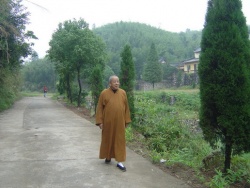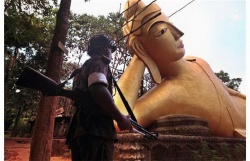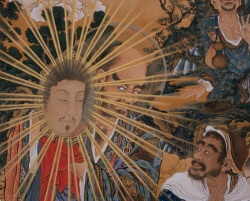What is Pure Land?
Pure Land is another name for one of the many the Buddha Lands. Actually, the original name was the Utmost Bliss and Pure Buddha Land. It is the place where sentient beings that have the similar deeds come to learn and cultivate their minds to become the future Buddha and are being supported by the Buddha’s vows and great compassion.
Why Buddha created the Pure Land?
Every Buddha has different methods to teach and help sentient beings. The Pure Land is the place where sentient beings who heard of that Pure Land and wish to come to study Dharma, to be able to defer their Karmas, to be able to have an excellent support structure for their quests to become the future Buddha. Think of it like a great school where you are fed, clothed, and taught, and have your financial debt deferred while you are learning and get strong.
Who is the leader of the Pure Land?
The leader of the Pure Land is the Buddha. There are many Pure Lands with many Buddhas. Only three were mentions as the famous Pure Lands (Pure Land of the Amita Buddha, Pure Land of Aksobhya Buddha, and the Pure Land of the Eastern Buddha) . (see "The three pure land sutras : a study and translation from Chinese / by Hisao Inagaki ; in collaboration with Harold Stewart" for details).
What Pure Land that we wish to be in?
Followed the Sakyamuni Buddha advice in the “Land of the Utmost Bliss” discourse, we wish to be in the Western Pure Land of Buddha Infinite Life and Infinite Light.
Who is the leader of that Pure Land?
The Amita Buddha is the leader of the Infinite Life and Infinite Light and Unhindered Light Pure Land.
Who said about such Pure Land?
The Pure Land was mentioned originally by the Sakyamuni Buddha in the “Land of the Utmost Bliss of the Amita Buddha” discourse.
Then the Buddha Sakyamuni explained about the Pure Land and its relation to sentient beings in the Ripitaka Sutrapitaka Vimalakirtinirdesa Sutra.
In various speeches, the Sakyamuni Buddha also mentioned in details different Pure Lands and the creators. Too many to listed here.
Where else the Amita Buddha name was mentioned?
1) The sutra of the Sixth Patriarch Hui Neng (tliuzu dashi: fa bao tan jing)(Phap Bao Dan Kinh)
2) The Saddharma Pundarika Sûtra (Kinh Phap Hoa)
3) Tripitaka Sutrapitaka Avatamsakasutra
4) And other discourses by various Zen Masters
What do I have to do in order to be in the Pure Land?
To be a good person alone will not be good enough for one to go to the Pure Land. To be a Buddhist alone will not be good enough to go to the Pure Land. To believe in Buddha alone will not be good enough to go to the Pure Land. You can go only go there if you:
1) Wished, wanted, and have a firm resolution that you want to be there.
2) Keep your precepts (10 heavenly precepts), do the Ten Good Deeds, and follow the Eight Folds Path.
3) Have great compassion for sentient beings.
Think of it as the school that will accept all applications and accept all levels, but at least you must be willing to enter. How can you enter the school if the minute they open the door for you, and then you start to leave? If you don’t do good, then at the time of your death, your karma would be so strong, then you could be in hell almost immediately leaving you no time to think of what you should have done.
Plus the more you prepare, the better you are. Don’t wait until you are thirsty then start the well digging process. You must at least have your self-respect to respect yourself and others.
Would the Buddha Amita’s vows be able to help me at the time of my death? Why should I have to do so much? If I have to work hard, and if that was the case, I should be able to go to different Pure Land on my own without his help, then why do I have to need him and his Pure Land?
If you are strong and have enough merits, yes then you can be free, be on your own, or go to heaven and enjoy the merits that you have accumulated. But when the merits run out, you will have to start from zero again. Understand the vows of Buddha Amita indicated that beings that born to his land would reach the level of non-regression, have the supreme senses and power that no other beings in other Buddha Lands could have for just being born there, almost like a company that would offer great salary, health care, vacation, and retirement package just for anyone to come and work for it equally. Without the support vows from Amita Buddha, it would take sentient beings eons just to reach the strength and power of the new born in the Amita Buddha land with NO WARRANTY that they could even do it by themselves, but it is WARRANTY by Buddha Amita vows. If one is arrogant enough to think that he or she does not need the support system from the Amita Buddha, then who’s going to stop them?
Shouldn’t Buddha with his great compassion take all of the sentient beings to his place without being asked? Why the sentient beings have to ask in order to go there?
That’s the Way’s rules of conduct. Ask, and you shall receive. If you don’t invite, then we won’t come. If you don’t ask for help, we must respect your decisions and will try to interfere with your business. That’s the Way of Dharma.
Shouldn’t this place, the land where Sakyamuni Buddha is the teacher of all, be as great as the land of the Amita Pure Land? This world is like hell to many sentient beings. What do you have to say?
This is the world with the name Saha. Saha means to bear, to be of great patient while bearing the misery life. All sentient beings here bear all burden, misery, defilement, and contention. Buddha Sakyamuni said that sentient beings here if cultivate their mind for the Buddha hood can really accelerate their progress thousand to million folds PER DAY. He said one day in this Saha world cultivating your Dharma is equivalent to hundreds or thousand of years in other land. Think of this world as the boot camp. Think of this world as the ultimate challenge where only the strong would pass and the weak could not. Think of this world as the weight lifting gym where the heavier the weigh, the stronger the presser. Therefore, if we feel that we could not last in here, then we should go to some other places where we would have a chance to escape. Only when we are strong and reach the stage of non-regression, shall we attempt to come back here to test our strength and to save sentient beings.
What is Zen?
Zen is a method that helps beings to reach the enlightenment stage. The true answer to Zen will come later.
Why Zen?
There are 84,000 dharanis or methods that help sentient beings to reach the enlightenment. Zen happened to be interested by human the most.
Who practice Zen?
Zen followers practice Zen. There is no time scale to perfect the process. Either you have it, or you don’t.
Benefit of Zen
It’s the faster route that allows the practitioners to reach the enlightenment more quickly than other methods.
Did the Sakyamuni Buddha mention anything about Zen?
Yes, he did. Zen is a subset of his meditation routine.
His first Zen student was one of the monks who could not memorize even one sentence of the verse no matter how hard he tried. Buddha then told him to contemplate on nothing but the word “sweep clean”. Sweep and clean all bad thought that arise in your mind, for his job was sweeping the ground in front of the monk dwelling places). He became the Arhat within a short time surprising everyone.
Why combine between Pure Land and Zen?
Not all people who pactice Zen would be able to escape the cycle of life and death. They are not all lucky enough to have an enlightenment master who knows how to coach them or answer. What if you could not reach the enlightenment but your life is already at the end, then you do need a safety net. This is why the Zen and Pure Land combination method works best for all sentient beings.
Beside, by concentrate on the name of the Amita Buddha alone, it has become the mantra that other Zen practitioners had done before (like concentrate on the meaning of one hand clapping ? or What was the reason for the BodhiDharma Patriarch to arrive to China or What was your face look like before you were born. etc. These are Zen mantras). It allows the practitioner to hit two targets with one stone, so to speak


